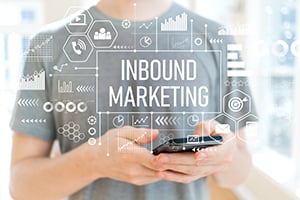
When comparing inbound and outbound marketing, it's important to understand what inbound and outbound marketing are, the different types of tactics used for both and why inbound marketing is more effective.
What is Inbound Marketing?
Have you ever stumbled across something online—maybe a product, an ad or some kind of digital download like an ebook or guide—that was exactly what you needed, exactly when you needed it? Whether you were searching in a search engine like Google, checking your email or reading a related article, chances are that you saw that specific content due to the efforts of a savvy inbound marketer.
You see, the way people have purchased has drastically changed during the last ten to twenty years. It used to be that all marketers would use invasive approaches such as introducing their products and services to the masses, whether those recipients were in need of that particular product or not.
But nowadays, prospects in both the B2B and B2C sectors are bombarded with hundreds of ads, emails, commercials and other digital content on a daily basis, so their patience has run out.
Now, the tables are turned and recipients are in control over what they will and will not choose to see from uninvited marketers. So you, as a marketer, have a choice to make...are you going to go after the people who may or may not need what you offer or the ones who have already raised their hands and self-identified themselves as more likely prospects?
Inbound marketing allows marketers to get an audience genuinely interested in their valuable content and have their audience come to them, which translates into higher conversion rates. Outbound marketing takes the opposite approach by inserting a salesperson or marketer into the audience's lives, whether they want or need the product or service.
Types Of Inbound Marketing
Inbound marketing is a giant field in and of itself, encompassing a wide and diverse range of marketing tactics, including:
- SEO
- Blogging
- Social media
- Web sites
- Modern linking strategies and
- Targeted content at all stages of the online buyer's journey
- To use any of these different tactics effectively as an inbound marketer, you must adhere to one golden rule of inbound marketing: help people.
You see, inbound marketing is above all about anticipating what your audience wants and needs, as well as the specific challenges they're facing which your product or service can help them overcome.
The most successful inbound marketers know that in order to truly attract buyers without seeming sleazy or overly aggressive, they need to take off their marketing hats and provide helpful, practical advice, tips and guidance. An inbound marketer's role has evolved into that of a trusted coach, advisor or friend who has established themselves as an authoritative expert and has gained their audience's trust online, using one or many of the tactics listed above.
It's important to note that most of this typically happens before a prospect has visited your business or picked up the phone to contact you. These days, prospects have almost all of the power and control in the early stages of the buyer's journey—so it's your job to take that power back and start controlling your company's destiny online by responding to their needs.
If someone is searching for a specific keyword, your content needs to appear. If they're reading an article on a related web site, they'll pay attention when they see a related ad or link directing them back to you. When they have a question about a specific pain point or challenge, you can bet they'll pay attention when they come across a how-to guide you've crafted about that specific problem and how they can solve it. Ask us if you're not sure which inbound tactics will be the best fit for your business.
Types Of Outbound Marketing
Outbound marketing includes:
- Radio commercials
- TV commercials
- Banner ads
- Paid ads
- Direct mail
- Cold calls to unqualified prospects and spam emails
Outbound marketing can be effective if you have a large budget and a large staff to ensure the message gets out to the largest possible audience. However, it is not as efficient as and costs more than inbound marketing, with a much lower ROI. You'll need to waste valuable time and resources weeding through a higher number of unqualified buyers, educating them about how your product or service can help and asking questions about their needs.
Can outbound marketing still work in 2020 and beyond? Sure, as long as you have the time, money and resources to invest in it...but inbound marketing will always be much, much cheaper and more effective than outbound. So why bother and when should you include outbound techniques?
With a few exceptions such as low-ticket impulse buys, you're usually better off focusing more money on inbound and taking advantage of the fact that you can find qualified buyers in places where nobody else in your industry may even be looking. Whether you or your competitors are online, you'll find that your prospects most definitely are!
Why Inbound Marketing Is More Effective
Inbound marketing tactics allow marketers to reach an audience who is already interested in their product or service, often at a much lower price than outbound techniques.
Successful inbound marketing professionals can anticipate their audience's questions and concerns. This allows marketers to create high-converting content that preemptively answers these questions and concerns without the need to target unqualified prospects.
Also, inbound marketing does not intrude into the audience's lives because the audience is offered valuable content that they consume when they are actively interested in a solution.
Need Help with Inbound?
Contact us today if you need help putting together a strategic game plan or inbound marketing plan that will save you time and money while getting better results.